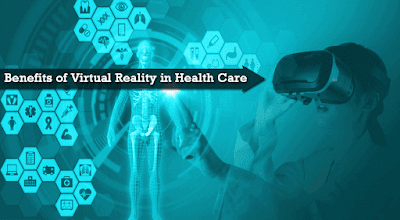Past few years have witnessed Virtual reality (VR) taking the world
by storm and this trend is only getting popular with every passing day.
Rapidly evolving technologies around us are changing the way we see the
world and how different industries operate. Although VR has
revolutionized the gaming industry, it is not restricted to a particular
field any more. There have been a lot of talks and discussions about
the use of VR in the healthcare industry, with numerous applications of
virtual reality already being implemented in healthcare. Applications
such as robotic surgery, healthcare devices, etc. are slowly gaining
popularity and are now more likely to be adopted by various healthcare
organizations and accepted by the people. In this article we have talked
about virtual reality and its applications in healthcare.
Virtual reality for healthcare is fundamentally different from other applications of virtual reality. Healthcare is an industry whose regulations and culture are not instantly familiar with the concept of VR. However, this does not prevent the development of new experiences based on virtual reality. VR aims to help patients communicate and improve their quality of life in real time or over long periods. To achieve this, one should use the technology in conjunction with medications, other kinds of therapy and treatments.
Virtual reality is a great support in the patient assessment process.
It provides visual aids for receiving feedback that will enable the
patient to be in the right position to assess and manage the symptoms.
VR devices can be used for the quick capture of vital information,
facilitating any interventions before procedures are conducted. These
devices that enable creating VR are:
Head-mounted display
– HMD products like the Oculus Rift, HTC Vive, Gear VR, or Google
Cardboard are devices that have a head strap mounted onto the user’s
head, with the display lenses and earphones attached to the strap.
Head-mounted displays provide an immersive virtual reality experience
where objects are placed in front of the user.
Smart glasses
– representing a new generation of smart devices, smart glasses are
used in healthcare to aid doctors in providing correct medical
procedures and diagnostic tests, thus improving clinical outcomes. For
instance, Google Glass is a pair of glasses used, among others, during
surgeries for video recording and data visualization.
Haptic gloves
– special gloves are designed to enable natural interaction with
virtual environments. They are one of the latest developments in the VR
world but already have the potential to bring change to the healthcare
industry. Capable of reproducing surgical simulations, the haptic gloves
can make the learning process more immersive and effective.
VR
technology can benefit both patients and practitioners. Virtual reality
can offer the potential for personalized treatment that does not rely
solely on a clinician’s own knowledge or intuition. It is this kind of
human-computer interaction (HCI) that is central to modern medicine.
VR for practitioners.
VR medical systems are to be used by healthcare professionals to better
serve their patients and also help doctors in a more personalized way.
The ease of use and the powerful processing power will enable clinicians
to deliver more efficient care. This will ultimately save the
healthcare industry money, improve patient care, and boost the bottom
line.
VR for patients. Virtual reality technology has the potential to radically improve patient care. Unlike videos or other 2D media that are, by definition, non-interactive, VR can simulate and convey a sense of presence for a patient in a comfortable, "video-game-like" setting. In fact, a user can enter an unrealized environment and feel as though they are physically present within it.




0 Comments